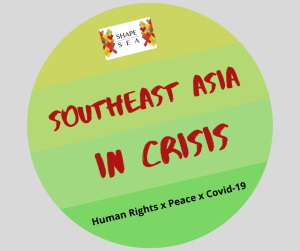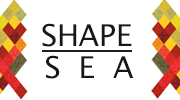Saw Lin HtetStudent, Asia Pacific MA Human Rights and DemocratisationGlobal Campus of Human Rights Asia PacificInstitute of Human Rights and Peace Studies, Mahidol University
 The government has been releasing public announcements to mitigate the spread Covid-19 in Myanmar. However, the official language, Burmese, proves to be challenging for ethnic peoples to fully grasp (Jacobsson, 2020). People who live in remote areas need information in their language in order to understand the situation and comply with health-related policies and guidelines. Furthermore, fake news and misinformation are spreading around, making it harder for the public to validate messages sent across. Language vulnerabilities have indeed exacerbated threats of Covid-19 towards peoples living at the margins and remote areas throughout the country (Minority Rights Group International, 2020).
The government has been releasing public announcements to mitigate the spread Covid-19 in Myanmar. However, the official language, Burmese, proves to be challenging for ethnic peoples to fully grasp (Jacobsson, 2020). People who live in remote areas need information in their language in order to understand the situation and comply with health-related policies and guidelines. Furthermore, fake news and misinformation are spreading around, making it harder for the public to validate messages sent across. Language vulnerabilities have indeed exacerbated threats of Covid-19 towards peoples living at the margins and remote areas throughout the country (Minority Rights Group International, 2020).
The UN Special Rapporteur on minority issues, Fernand de Varennes, expressed his concern on 30 March 2020 about the absence of pandemic information in minority languages, including sign languages (OHCHR, 2020). The Director-General of the World Health Organization, Tedros Adhanom Ghebreyesus, also highlighted that “we are not just fighting an epidemic, we are fighting an infodemic.” (TWB, 2020).
There have been a number of efforts to bridge gaps in language barriers related to measures combatting Covid-19. The World Health Organization established the OpenWHO web-based platform to offer real-time online training in different national languages (WHO, 2020). In Myanmar, WaterAid Myanmar produced the Covid-19 awareness flyer for three ethnic languages in February (WaterAid Myanmar, 2020). On 23 March, the Ministry of Health and Sports published the Covid-19 preventive info sheet in four ethnic languages on its Facebook page (Ministry of Health and Sports Myanmar, 2020). An Ethnic Armed Organization, Karen National Union Headquarters, also uploaded the awareness flyers on its Facebook on 26 March (KNU, 2020).
Guidelines for Covid-19 prevention are currently available on the web in Akha, Chin, Chinese, Danu, Kachin, Kayah, Kayan, Kayin/Karen (Poe and Sagaw), Lahu, Lisue, Mon, Pakanyaw, PaOh, Rakhine, Rohingya, Shan, and Zawtnak Kong. They are also available on the Myanmar Information Management Unit’s website with audios, videos, and messages in different languages (MIMU, 2020). Sometimes, some ethnic media also provide Covid-19 online information. However, online platforms are not accessible to ethnic peoples living in remote areas, where interent services are unavailable, costly, and heavily regulated. Worse, in Rakhine and Chin states, the state completely shut down the internet. While Translation efforts are being done to raise awareness, official announcements and public orders are yet to be made available in ethnic languages.
Aung Thu Nyeen from Institute for Strategy and Policy Myanmar said that the government should disseminate information more directly and inclusively. He proposed using ethnic languages and community radio programs as a means to send messages widely across. (Jacobsson, 2020). According to Article 4(e) of Myanmar Ethnic Rights Protection Law, 2015, all ethnic people have equal rights in education, health care, employment opportunity, and doing business (ILO, 2015).
The right to information is universal, according to Article 19 of the Universal Declaration of Human Rights. It is directly linked ones right to access health-related education and information, as per ICESCR Article 12, General Comments 14 and 22 (Dutta, 2016). In order to combat COVID-19, everyone should be able to enjoy the right to easily available, accurate, and accessible information. Dissemination also should be improved by applying effective and inclusive means of communication to address infodemic and pandemic in Myanmar. The Government of Myanmar, together with civil society groups, must take immediate efforts to ensure that rights to information in the minority and ethnic languages are attained.
References:
Aljazeera, 2017. Myanmar: Major ethnic groups and where they live. on 14 March. Available at: < https://www.aljazeera.com/indepth/interactive/2017/03/myanmar-major-ethnic-groups-live-170309143208539.html> .
Dutta, K., 2016. Checklists for Core International Human Rights Treaties: A Handbook. Bangkok: Asia Institute for Human Rights. Available at: <http://www.aihrhre.org/download/checklists-core-international-human-rights-treaties/> .
ILO, 2015. Indigenous and Tribal Peoples. Available through: < https://www.ilo.org/dyn/natlex/natlex4.detail?p_lang=&p_isn=100496&p_classification=21> .
Jacobsson, A. S., 2020. Myanmar: Community media Stops Covid-19 panic. 2 April. Available at: < https://www.mediasupport.org/community-media-stops-covid-19-panic-in-myanmar/> .
KNU, 2020. 26 March. Available at: <https://www.facebook.com/knuheadquartersofficial/photos/pcb.2625949867687446/2625948834354216/?type=3&theater> .
MIMU, 2020. Coronavirus disease (COVID-19) Pandemic. Myanmar Information Management Unit, 18 April. Available at: <http://themimu.info/emergencies/coronavirus-disease-2019-covid-19> .
Ministry of Health and Sports Myanmar, 2020. Covid-19 Preventive awareness in Pwo, Sgaw, Rakhine, and Tedim languages. on 24 March. Available at: < https://www.facebook.com/pg/MinistryOfHealthAndSportsMyanmar/posts/?ref=page_internal> .
Minority Rights Group International, 2020. Report Covid-19 Discrimination. Available at: < https://minorityrights.org/coronavirus/report-discrimination/> .
OHCHR, 2020. Covid-19 Fear should not be exploited to attack and exclude minorities “ UN Expert. 30 March. Available at: < https://www.ohchr.org/EN/NewsEvents/Pages/DisplayNews.aspx?NewsID=25757&LangID=E> .
RFA talk, 2020. RFA, 2 May 2020 13:14. Available through: <https://www.facebook.com/rfaburmese/videos/613702509218029/?comment_id=146373620259663¬if_id=1588431462583967¬if_t=feedback_reaction_generic> .
TWB, 2020. Translators Without Borders tickle COVID-19 “infodemic.” Translators Without Borders, 08 April. Available at: <https://translatorswithoutborders.org/twb-tackles-covid-19-infodemic-april/?utm_source=rss&utm_medium=rss&utm_campaign=twb-tackles-covid-19-infodemic-april> .
WaterAid Myanmar, 2020. 2019 Novel Coronavirus awareness information in Sgaw Karen language. . 3 February. Available at: <https://www.facebook.com/pg/wateraidmyanmar/posts/?ref=page_internal> .
WHO, 2020. Responding to COVID-19, Real-time training in national languages. Available at: https://openwho.org/channels/covid-19-national-languages .





